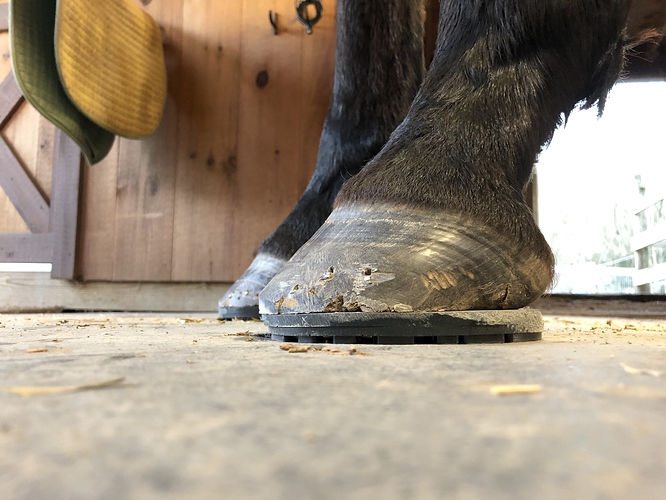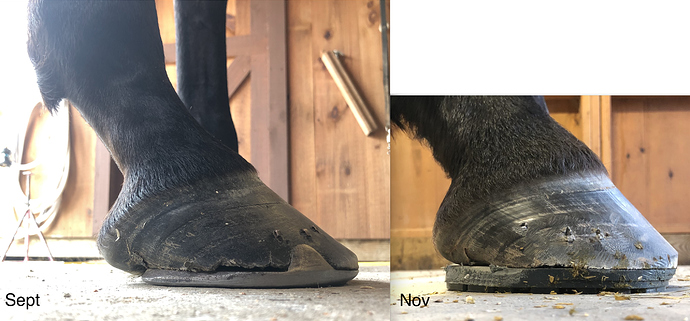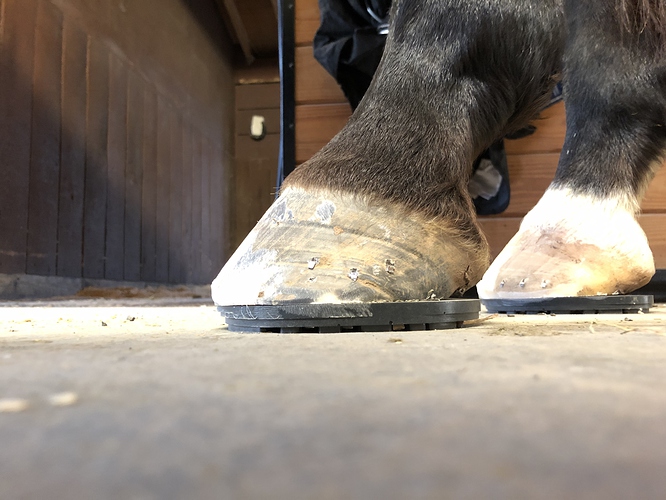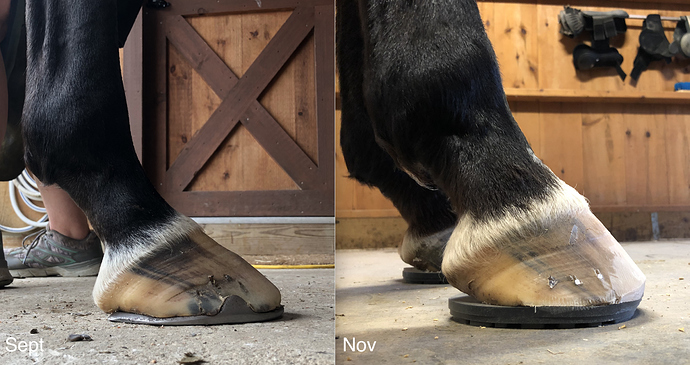Yep, while some NPA horses are developing too much vertical toe height, many of them are not. Many of them are too thin-soled there to take anything down. Many times it’s not even about horizontal toe length either. My OTTB mare does tend to get tall hind toes, so she’s one I can rasp into the sole a little - a little! - and still have her sound. But I’ve seen too many xrays of other NPA horses where it does look like, from the outside, there’s a lot of toe height you can take off, but the rads say otherwise.
Let me clarify my earlier statement -
I was not saying take a huge chunk of depth out all in 1 go. It may be a couple passes or the rasp that is all that can be taken, but it is important to take it when you can and need to. If the horse is shod, take more depth, if not, take as much as you can without making them uncomfortable and work on getting that angle lowered. There’s nothing quick with feet, I didn’t say cut a huge amount away, but depth does NEED to be taken from a LOT of NPA horses.
Farrier A shod the horse more fully to support the underrun heels. Farrier B: To make up for the long toes, the shoe is heavily rockered at the toe. This is a difficult situation. You need the horse’s heels to grow down and the breakover to be adjusted to take the pressure off of the toe through correct trimming, not just through the shoe. A bar shoe is a good recommendation, however, if you are considering going that direction, be sure to find someone who knows how to apply them - not just talk about them - preferably someone has forged them at some point and has experience with the outcome. Going barefoot for a few cycles might be a really good idea too. You will still need someone who knows how to manage this type of hoof conformation - a horse that can easily go long toe, low heel. It can be done.
Okay, another update. Here he is just after being done for the second time by Farrier A again (meaning, after the two cycles with Farrier B during which bad, bad things happened). Thoughts?
LH:
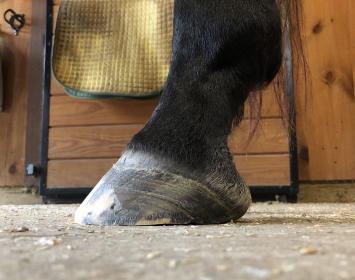

RH:
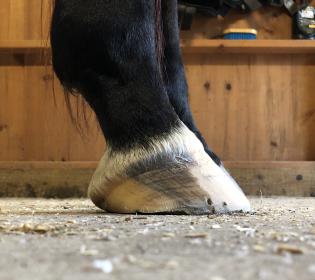

Too many attachments…fronts to follow.
LF:
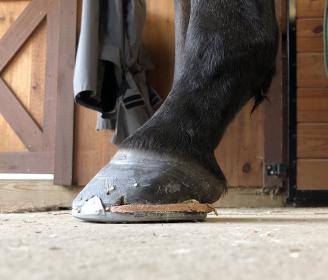
RF:
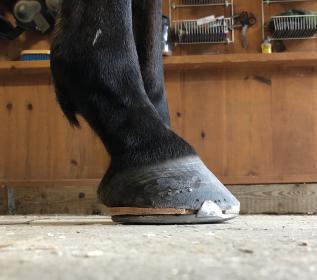
MUCH better… there are still a couple of things that need to happen. Let me do some mark ups for you. Is there DIM under the wedge pad?
Thanks in advance for the mark-ups! Underneath the pads is Equi-Pak Soft.
Those are starting to look a lot better. It’s been interesting to follow.
So what you do with the hind feet will depend on whether you keep them bare for now… I can’t seem to get the pictures to post here, so I will send them in a pm (if that works).
Unless the horse tells me it’s no longer working for him, I plan to keep the hinds bare through the winter and reassess before spring events start. It would be great if he could stay barefoot behind permanently. He does still avoid the gravel driveway and sometimes prefers to walk in the grass rather than on the stonedust path to the field, which could be problematic in the winter since my dry lot is stonedust too. We will see how it goes. I did buy him some hoof boots for trail rides because our stream crossings are very rocky, and so far that seems to be working well.
Things do look better! :yes:
Are the hinds after the whole trim? Did he clean up the lateral bars on both?
Yes, that is the finished trim. I see why you asked about the bars. I looked at them again this afternoon and they look much more prominent in the photos (RH especially) than in person. I can ask the farrier to touch them up when she comes for one of my other horses next week though.
Forgot to mention that the farrier suggested treating the hinds for white line so I’ve ordered some Oxine.
The lateral bars may not be prominent, but they are clearly laid over, RH worse, which will continue to cause pressure in the quarters.
Thanks for clarifying that–makes sense!
So here are updated hoof rads from a week after the shoeing job shown in my Oct 12 photos. Any thoughts? Last set of rads (from Dec 2019) are in post 6, for comparison.
LF:
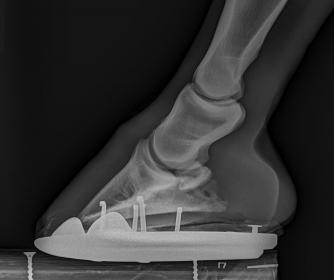
RF:
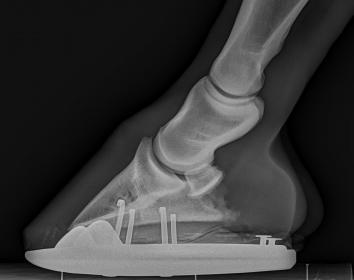
LH:
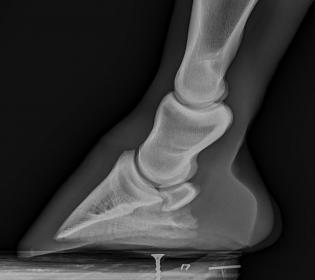
RH:
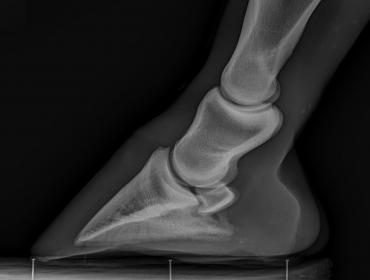
@Libby2563 no comment on the x-rays, but the photos look much better to my eye!! definitely better than that other farrier.
He’s so lucky to have such a dedicated horse owner!
To my uneducated eye the feet look so, so much better going back to farrier A. I hope things continue to improve.
Looks better than page 1, but I don’t get why he got the heel on the LF properly back and trimmed the bars, but left the RH too long and not trimming the bars. Maybe I’m something. The heel should line up with buttress of the heel. With it being left forward, it’s more prone to being pulled forward by the toe and becoming crushed and underrun.
Riding him in boots and pads on his hind feet might really help develop the heels and will help with comfort as well. I would pad the heels to help them engage… riding hills, trot polls also help with that as well. I’ve also successfully used weighted bell boots in the hind feet. The extra few ounces gets them to pick the feet up higher and set the foot down so the heels engage the ground first.
Since I linked to this on someone else’s farrier thread, I thought I would update again. For her third cycle back, Farrier A and I discussed some other shoeing options: steel shoes with pour-in pads, flip flops, and Eponas. We decided to try the Eponas on all four. (He needed some protection behind as he just wasn’t entirely comfortable barefoot, even with boots for riding.) Here are some pics, with before photos where I have them:
LF:
RF:
LH:
RH:
Frustratingly, after about 10 days he went quite lame in front, worse on the RF. After discussion with the farrier, I pulled both front shoes (which was very, very difficult compared to steel shoes). Under the RF I found that the lateral bar had formed a weird ridge. There was also a semicircular ridge on the sole about where the blue gel padding in the shoe was touching it. It was really bizarre. They stayed off for five days (with padded hoof boots for turnout) and I did some Oxine soaks. The ridges on the RF were significantly smaller within 24 hours and disappeared completely in another day or two. Within a few days he was as sound as he can be barefoot right now.
About a week ago the farrier came back and put steel shoes with Equipak on the fronts, and he is sound and happy again. He still has Eponas on the hinds. I do think his feet are headed in the right direction (although it’s been a bit of a battle and I know there’s still room for improvement) and I’m grateful to Farrier A for taking me back and always being willing to brainstorm about this guy.
(I also went back and edited a lot of posts to clean up gobbledygook injected by the forum change into posts with photos.)
Oh, that’s definitely some progress! Congrats!

